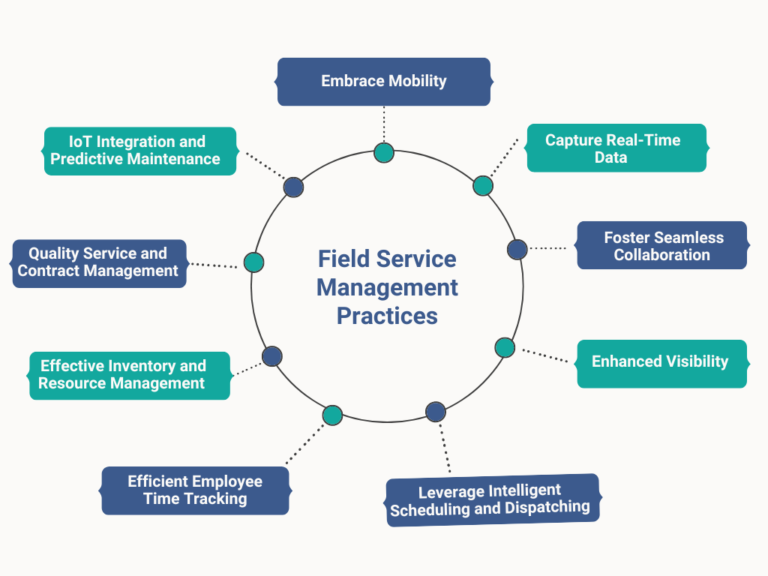Field service organizations face an overwhelming number of tasks each day.
Field equipment management, scheduling field personnel, inventory management, workflow management, creating and assigning field tickets, and much more.
Field service managers have lots on their plates.

More and more businesses embrace digitalization for more efficiency. Therefore, continuing with outdated, manual processes affects various aspects of your oil and gas business. You’re likely experiencing inefficiencies, increasing costs, unsatisfied customers, and frequent downtime.
Implementing field service management best practices can help your oil and industrial field services organization achieve multiple benefits. These are streamlined operations, enhanced productivity, client satisfaction, maximum uptime, and improved employee retention rates.
Let’s explore them in more detail.
One of the field service management best practices is providing your personnel with a mobile field service management application. Your field technicians can instantly access the mobile app to view customer information, schedule work orders, and capture real-time data.
They can clock in and out from their device after each job, which ensures accurate payroll. Moreover, real-time notifications keep them in the loop on any changes to their schedule.
Field service technicians using mobile field service apps are better informed about job updates and safety procedures. They also collaborate seamlessly with other team members, which helps them achieve greater efficiency in their work.
Top-rated organizations use powerful field service automation software. It captures real-time data from the field workforce or directly from the equipment to analyze performance-critical metrics.
Don’t lag behind your competitors. Choose a platform that is easy to use and offers real-time dashboards and reports. They will give you a comprehensive view of all past, current, and future field activities.
Improved scheduling and communication enable quicker problem resolution and transparency across all field service operations. This, in turn, will help you establish a more positive business image.
An integrated field service management platform ensures all your customers, back-office team members, and field technicians are on the same page. This facilitates seamless collaboration and encourages job accountability and transparency.
Field service organizations can implement automated workflows to easily manage recurring tasks. This also helps speed up processes while minimizing manual intervention and errors.
Automation can considerably reduce response times. Field service personnel receive instant notifications about new tasks, their priority, the assigned personnel, the customer profile, etc.
Real-time visibility into all tasks and processes is critical. This allows all stakeholders to keep track of tasks, identify potential loopholes, and take necessary corrective actions.
Real-time tracking provides the latest site and activity information of your field technicians and equipment. This allows field and back office managers to check staff availability and location. Thus, they can assign tasks to the field crew with the right skills and the shortest travel time to maximize overall technician productivity.
Accurate equipment performance data allows oil field service technicians and supervisors to schedule preventive and predictive maintenance programs. So, they can ensure maximum uptime and enhanced worker safety.
Intelligent scheduling and dispatching are critical to field service management organizations. The expectations of today’s customers are continuously growing. They want service providers to proactively offer equipment servicing and maintenance as well as to be highly responsive in emergencies.
Also, customers expect well-qualified field technicians to deliver quality service, thus adding value to their field operations.
Here’s how the oil and industrial field services industry can leverage field service scheduling and dispatch:
Minimizing time wastage or unnecessary time consumption remains one of the main challenges for field service organizations. This is especially true for those operating in the oil and gas sector, where providing timely services is essential.
Here’s why accurate time tracking in field service management is replacing manual time tracking at a fast pace:
Automated time tracking can benefit you in various ways. Nonetheless, choosing the right time-tracking software that offers a complete solution for field service organizations is key. Look for one with features such as GPS tracking, Third-party Integration, Bulk entry, and Timecards.
Field service businesses often need help with issues like inventory shortage, shifts in demand, risk of damage or theft, and over-stocking. Smart inventory management helps optimize operations, improve service delivery, and ensure customer satisfaction.
As one of the field service management best practices, smart inventory management can help field service businesses in various ways:
Asset information includes service history, service manuals, current output, schematics, and more. Instant access to it provides your field service technicians and roustabout crew with valuable insight. It enhances troubleshooting and repair processes, leading to timely resolution and improved customer satisfaction.
Quality service and contract management are critical for field service businesses. They help ensure compliance, customer satisfaction, and revenue gains.
Here’s how equipment-specific checklists help field service technicians deliver comprehensive and consistent troubleshooting, servicing, and maintenance of different types of equipment:
Contract management allows field service companies to create tailored service agreements based on every client’s unique requirements. Tracking key metrics such as job completion rates and response times helps managers review performance and analyze areas of improvement.
Internet of Things (IoT) equipment monitoring and predictive maintenance are powerful next-gen technologies. They help oil and industrial field companies maximize asset uptime. It can also significantly improve servicing quality. Here’s how:

Intelligent Analytical Models in the form of informative charts and reports provide enhanced visibility into equipment performance metrics. By analyzing the data, the management can make timely decisions. Thus, your company can ensure optimal equipment performance. You can also improve work safety standards and deliver exceptional service to valued clients.
The field service industry continues to get more competitive through digitalization. Thus, decision makers must implement field service management best practices. This will ensure optimal equipment and personnel performance while eliminating outdated, tedious manual input processes.
To achieve the best results, you will have to invest in powerful, robust, and reliable field service management software like FieldEquip. It offers a host of next-gen features, such as field ticketing, work order management, scheduling and dispatch, preventive maintenance, and more.
Would you like to have a free demo or have any questions about FieldEquip?
US Corporate Headquarters 1011 S. Hwy. 6, Suite 117 Houston Texas 77077 US